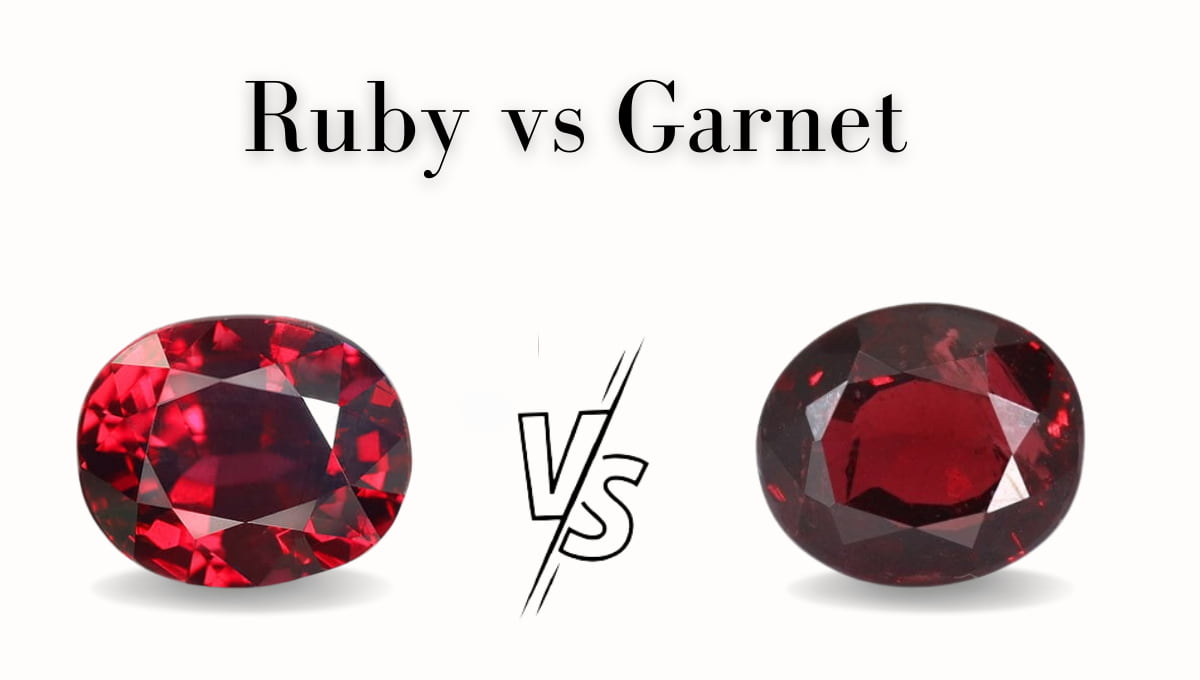Since time immemorial, human beings have had this innate tendency to compare elements that are revered, highly prized, and of paramount significance. In the enormous and magnificent realm of gemstones, ruby, and garnet are two bodacious gemstones that have been subjected to constant comparison for eons because of umpteen striking similarities, physical properties, and astrological benefits.
While Ruby belongs to the corundum family and is no less than yellow sapphire stone or blue sapphire in terms of stature, garnet is the stone of the masses with massive implications in the domain of affordable jewelry and astrology. When it comes to picking between a ruby stone and a garnet gemstone, people often get confused as they share a jaw-dropping resemblance and numerous other characteristics that are similar and make it more difficult for people to choose any one between them.
The prime and sole purpose of this blog post is to distinguish between ruby and garnet stones on the basis of numerous vital parameters like origin, physical properties, value, internal composition, and astrological benefits. At the end of the blog post, you will be more than competent to compare ruby vs garnet and pick the best gemstone for you.
Ruby vs Garnet: Origin
Ruby: Ruby is one of the most coveted precious gemstones and is an integral variety of the mineral corundum (aluminum oxide). The lush or deep red color of ruby is because of the presence of the element chromium in the crystal lattice structure. The intensity and uniformity of the red color in a Manik stone determine its value, with the most valuable rubies having a deep red color with a hint of blue.
The major sources of top-notch quality rubies historically have been Myanmar (formerly Burma), Thailand, and Sri Lanka. In recent years, other significant sources of rubies including Mozambique, Madagascar, and Afghanistan have also arrived into the picture.
Garnet: Garnet, on the other hand, is a group of related minerals with various colors, including red, orange, yellow, green, purple, and brown. The most commonly known red garnet is called pyrope, which is a magnesium aluminum silicate. Unlike ruby, garnets do not contain chromium but derive their red color from different trace elements.
Garnets are one of the few gemstones that can be effortlessly found worldwide, especially in the United States, Brazil, India, Sri Lanka, and several African countries. Garnets have been heavily used in jewelry and other decorative items for thousands of years and have a rich history in various cultures.
Ruby vs Garnet: Composition
Ruby and garnet gemstones both resemble profoundly in color, but their internal composition and crystal structure differs greatly. Let’s have a look at their composition one at a time.
Ruby is one of the most fabled varieties of the mineral corundum. It is a hard and transparent mineral that is made up of aluminum oxide (Al2O3). The red color of ruby is caused by the presence of chromium impurities within the crystal structure.
Contrary, Garnet is a group of silicate minerals that can be found in a variety of colors. The most common garnets are pyrope (red), almandine (red), spessartine (orange), and grossular (green). The color of the garnet gemstone is determined by the chemical composition of the mineral. For example, pyrope garnets are red because they contain magnesium and iron, while almandine garnets are red because they contain iron and aluminum.
Do Peek Here: – How To Wear Ruby Stone
Garnet vs Ruby Color
Garnet Color: Garnet gemstones come in a plethora of colors, including red, orange, yellow, green, purple, brown, and even black. The most sought-after color in garnets typically has a deep red to purplish-red hue, also called pyrope. Other red garnet varieties include almandine, spessartine, and rhodolite also enclose different shades of red with variations in degree of color.
The specific color of garnet is determined by the presence of different trace elements within the crystal structure. The red color in garnet is because of the traces of iron elements.
Ruby Color: Ruby is known for its intense red color, which ranges from a vibrant red to a slightly purplish-red or orangish-red shade. The color of ruby is caused by the presence of the element chromium in the corundum crystal structure. The more chromium present, the more vivid and desirable the red color becomes.
Garnet vs Ruby Physical Properties
In this section, we have compared the physical properties of ruby gemstone and garnet stone on the basis of different factors.
Hardness is a measure of how resistant a mineral is to scratching or breaking down under forced or natural stress. To measure hardness, the Mohs scale of hardness is used which ranges from 1 to 10, with 1 being the softest and 10 being the hardest. Ruby is the second hardest mineral on the Mohs scale after diamond as it has a rating of 9. Garnet, on the other hand, is much softer than ruby with a hardness of 6.5–7.5 on the Mohs scale.
Another vital physical property is a refractive index which is a measure of how much light is bent when it passes through a mineral. The higher the refractive index, the more light is bent. Ruby has a higher refractive index than garnet, which means that ruby will sparkle more than garnet. That’s why the brilliance of a Ruby gemstone is always ranked higher.
Specific gravity is also taken into account when it comes to making a comparison between two similar-looking gemstones. It is a measure of the density of a mineral. The specific gravity of a mineral is calculated by dividing its mass by its volume. Ruby has a higher specific gravity than garnet, which means that ruby is denser than garnet.
Luster can be defined as the ability of the gemstone to reflect light when it falls on the surface. Ruby has a vitreous luster, which means that it reflects light like glass. Garnet also has a vitreous luster, but it can also have a resinous luster, which means that it reflects light like resin.
Fracture is the way that a mineral breaks. Ruby has a conchoidal fracture, which means that it breaks in smooth, curved surfaces. Garnet also has a conchoidal fracture, but it can also have an uneven fracture.
Color zoning is the occurrence of different colors in different parts of a mineral. Ruby and garnet can both exhibit color zoning.
Inclusions are small particles or defects that are trapped within a mineral. Ruby and garnet can both contain inclusions.
Also Look At: – How to Tell If A Ruby is Real
Garnet vs Ruby Price
Without a shadow of a doubt, an original ruby gemstone is a multitude of times more valuable than a garnet stone. Sometimes, the ruby stone price per carat of a Burma-origin ruby can go to $1 million per carat which is staggering and unbelievable. On the other hand, garnet stone price begins at somewhere around $20-50 per carat and can go as high as $1000 to $3000 per carat.
Ruby and garnet gemstones of particular origins usually cost more because of the rarity in color, size, and clarity of the gemstones. Manik gemstones of Burma, Mozambique, and Tanzania origins are hailed the most. Whereas, India is one of the principal sources of unrivalled quality garnet stones.
Ruby vs Garnet: Astrological Benefits
Both ruby gemstone and garnet stone are of enormous astrological significance and influence the numerous aspects of the life of different Zodiac signs.
Ruby and garnet are both gemstones that have been associated with astrology for centuries. Here is a brief overview of the astrological benefits of ruby and garnet:
Ruby is associated with the zodiac sign Leo and the planet Sun. It is said to bring courage, passion, and vitality to the wearer. Ruby is also said to promote good health, wealth, and success.
Garnet is associated with the zodiac signs Aquarius and Capricorn. It is said to bring protection, strength, and determination to the wearer. Garnet is also said to promote love, friendship, and harmony.
The astrological benefits of ruby and garnet can vary depending on the individual wearer. However, both gemstones are said to be powerful and protective stones.
Must Read: – Who Can Wear Ruby Stone
Rubs vs Garnet: Zodiac
If we talk about the relation of Zodiac signs with Manik and garnet gemstones, these potent gemstones are connected deeply with different Zodiac signs and influence the lives of wearers profoundly.
Garnet is the official birthstone of January month and Ruby is the birthstone of July month. Thus, people born in the month of January and July can embrace garnet and ruby gemstones respectively. While Ruby gemstone exemplifies the Planet Sun whereas garnet represents the planet Venus. Ruby stone widely influences the lives of individuals with cancer Zodiac sign and garnet stone showcases its impact on Capricorn Zodiac.
Ruby vs Garnet: Popularity
Ruby Popularity: Unquestionably, Ruby has been one of the most popular and prized gemstones for umpteen years. It holds a significant place in various cultures and has been associated with royalty, wealth, and passion. The allure of its deep red color and its rarity contribute to its desirability. Historically, some of the most famous rubies have been owned by royalty and displayed in crown jewels, enhancing their prestige.
Rubies are commonly used in engagement rings, necklaces, bracelets, and other high-end jewelry pieces. The popularity of ruby jewelry is further boosted by the endorsement of celebrities and public figures who wear ruby-adorned accessories at red carpet events and other public appearances.
Garnet Popularity: Garnet, too, is a popular gemstone, but it generally has a different market and appeal compared to rubies. Garnets come in a variety of colors, and each variety has its own distinct charm. Red garnets, particularly pyrope and almandine, have a more affordable price range compared to rubies, making them accessible to a broader market.
Garnets have been popular throughout history and have been used in various types of jewelry, including rings, earrings, and pendants. The diverse range of colors and their affordability have made garnets an attractive choice for those seeking unique and budget-friendly gemstones.
Check Out: – Ruby vs Pink Sapphire

